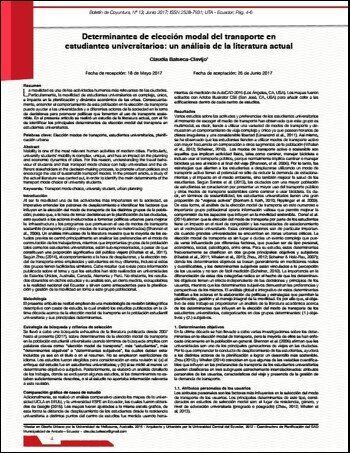Determinantes de elección modal del transporte en estudiantes universitarios: un análisis de la literatura actual
Contenido principal del artículo
Resumen
La movilidad es una de las actividades humanas más relevantes de las ciudades. Particularmente, la movilidad de estudiantes universitarios es compleja, única, e impacta en la planificación y dinámica económica de las urbes. Consecuentemente, entender el comportamiento de esta población en la elección de transporte puede ayudar a las universidades y a diferentes actores de la sociedad en la toma de decisiones para promover políticas que fomenten el uso de transporte sostenible. En el presente artículo se realizó un estudio de la literatura actual, con el fin de identificar los principales determinantes de elección modal del transporte en estudiantes universitarios.
DOI: https://doi.org/10.31164/bcoyu.13.2017.628
URL: http://revistas.uta.edu.ec/erevista/index.php/bcoyu/article/view/628
Descargas
Detalles del artículo

Esta obra está bajo una licencia internacional Creative Commons Atribución-NoComercial 4.0.
![]()
Las publicaciones del Boletín de Coyuntura están bajo una licencia de Creative Commons Reconocimiento-NoComercial 4.0 Internacional (CC BY-NC 4.0). La Universidad Técnica de Ambato conserva los derechos patrimoniales (copyright) de las obras publicadas, y favorece y permite la reutilización de estas, siempre que: se cite la autoría y fuente original de su publicación, no se usen para fines comerciales u onerosos. La propiedad intelectual de los artículos publicados pertenece a los autores de los mismos.
Citas
AOUN, A., ABOU-ZEID, M., KAYSI, I., MYNTTI, C., 2013. Reducing parking demand and traffic congestion at the American University of Beirut, Transport Policy 25, 52-60.
AJZEN, I. 1991. The theory of planned behavior. Organizational Behavior and Hu-man Decision Processes, 50, 179-211.
BAMBERG, S. & SCHMIDT, P. 1998. Changing travel-mode choice as rational choi-ce: Results from a longitudinal intervention study. Rationality and Society, 10, 223-252.
BONHAM, J., KOTH, B., 2010. Universities and the cycling culture, Transportation Research - Part D 15,2, 94-102.
DANAF, M., ABOU-ZEID, M., & KAYSI, I. 2014. Modeling travel choices of students at a private, urban university: insights and policy implications. Case Studies on Transport Policy, 2(3), 142-152.
DELMELLE, E. M. & DELMELLE, E. C. 2012. Exploring spatio-temporal commuting patterns in a university environment. Transport Policy, 21, 1-9.
EOM, J., STONE, J. & GHOSH, S. 2009. Daily Activity Patterns of University Stu-dents. Journal of Urban Planning and Development, 135, 141-149.
GÄRLING, T. & SCHUITEMA, G. 2007. Travel Demand Management Targeting Re-duced Private Car Use: Effectiveness, Public Acceptability and Political Feasibility. Journal of Social Issues, 63, 139-153.
GOOGLE, 2015a. UCLA, Estados Unidos en Google maps. Imagen en 2D, visualizado el 20 mayo 2017, en: https://www.google.es/maps/place/Universidad+de+-California+en+Los+%C3%81ngeles/@34.0689254,-118.4473698,649m/data=!3m2!1e3!-4b1!4m5!3m4!1s0x80c2bc85f05c0f65:0x25a993585c134837!8m2!3d34.068921!4d-118.4451811
GOOGLE, 2015b. Universidad de las Fuerzas Armadas, Ecuador en Google maps. Imagen en 2D, visualizado el 20 mayo 2017, en: https://www.google.es/maps/place/ Escue-la+Polit%C3%A9cnica+del+Ejercito/@-0.3159044,-78.4459022,16.25z/ data=!4m5!3m4!1s0x-91d5bd12538eb13b:0x907c61f1abbe45ab!8m2!3d-0.3145357!4d-78.4436917
KERR, A., LENNON, A. & WATSON, B. 2010. The call of the road: factors predicting students’ car travelling intentions and behaviour. Transportation, 37, 1-13.
KHATTAK, A., WANG, X., SON, S. & AGNELLO, P. 2011. Travel by University Stu-dents in Virginia. Is This Travel Different from Travel by the General Population? Transportation Research Record, 2255, 137-145.
KLÖCKNER, C. A. & FRIEDRICHSMEIER, T. 2011. A multi-level approach to travel mode choice – How person characteristics and situation specific aspects determine car use in a student sample. Transportation Research Part F: Traffic Psychology and Behaviour, 14, 261-277.
LIMANOND, T., BUTSINGKORN, T., CHERMKHUNTHOD, C. 2011. Travel behavior of university students who live on campus: a case study of a rural university in Asia, Transport Policy 18, 163-171.
MANN, E. & ABRAHAM, C. 2012. Identifying Beliefs and Cognitions Underpinning Commuters’ Travel Mode Choices. Journal of Applied Social Psychology, 42, 2730-2757.
MARIÑO, C. A. 2014. Reporte preliminar: Entendiendo las preferencias y actitudes al escoger el medio de transporte en estudiantes universitarios. Saber y Hacer, 1(1), 11-25.
PÁEZ, A. & WHALEN, K. 2010. Enjoyment of commute: a comparison of different transportation modes. Transportation Research Part A: Policy and Practice, 44, 537-549.
RIPPLINGER, D., HOUGH, J., BRANDT-SARGENT, B., 2009. The changing attitu-des and behaviors of university students toward public transportation: final report, Small Urban and Rural Transit Center. Upper Great Plains Transportation Institute. North Dokota State Univer-sity. Fargo, North Dokota.
SCHEINER, J. 2010. Social inequalities in travel behaviour: trip distances in the context of residential self-selection and lifestyles. Journal of Transport Geography, 18, 679-690.
SCHEINER, J. & HOLZ-RAU, C. 2007. Travel mode choice: affected by objective or subjective determinants? Transportation, 34, 487-511.
SCHNEIDER, R. J. 2013. Theory of routine mode choice decisions: An operational framework to increase sustainable transportation. Transport Policy, 25, 128-137.
SHANNON, T., GILES-CORTI, B., PIKORA, T., BULSARA, M., SHILTON, T. & BULL, F. 2006. Active commuting in a university setting: Assessing commuting habits and potential for modal change. Transport Policy, 13, 240-253.
TAYLOR, C. J., NOZICK, L. K. & MEYBURG, A. H. 1997. Selection and evaluation of travel demand management measures. Transportation Research Record: Journal of the Trans-portation Research Board, 1598, 49-60.
WHALEN, K. E., PÁEZ, A. & CARRASCO, J. A. 2013. Mode choice of university students commuting to school and the role of active travel. Journal of Transport Geography, 31, 132-142.
ZHOU, J. 2012. Sustainable commute in a car-dominant city: Factors affecting al-ternative mode choices among university students. Transportation Research Part A: Policy and Practice, 46, 1013-1029.
ZHOU, J. 2014. From better understandings to proactive actions: Housing location and commuting mode choices among university students. Transport Policy, 33, 166-175.


